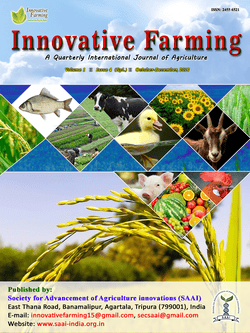
Scientific Agricultural Practices for Increase Production of Pigeon Pea
Dinesh Kumar Marapi*
Indira Gandhi Krishi Viswavidyalaya, Raipur, Chhattisgarh, India
Hemant Kumar Jangde
Indira Gandhi Krishi Viswavidyalaya, Raipur, Chhattisgarh, India
Saurabh Kumar
Indira Gandhi Krishi Viswavidyalaya, Raipur, Chhattisgarh, India
Lokesh Kumar Tinde
Bidhan Chandra Krishi Viswavidyalaya, Mohanpur, District Nadia, West Bengal, India
Gyanendra Kumar
Bidhan Chandra Krishi Viswavidyalaya, Mohanpur, District Nadia, West Bengal, India
DOI: NIL
Keywords: Pigeon pea, nutritional value, pulse, legume
Abstract
Pigeon pea (Cajanus cajan (L.) Millsp.), known by several vernacular and trade names such as red gram, tuar, Angola pea, Congo pea, yellow dhal and oil dhal, is one of the major grain legume crops of the tropics and sub-tropics. Pigeon pea is rich in starch, protein, calcium, manganese, crude fiber, fat, trace elements, and minerals. It is a hardy plant that can grow at temperatures as low and drought condition. Stagnant production, soaring prices, and enhanced imports of pigeon pea (red gram) have been matter of concern to the prime stakeholders in India. Improved technologies and efficient use of farm inputs under the changing environmental conditions can make pigeon pea production sustainable and profitable.
Downloads
not found
Reference
Allen, O. N., & Allen, E. K. (1981). The Leguminosae: A source book of characteristics, uses, and nodulation. The University of Wisconsin Press, Madison.
Hulse, J. H. (1977). Problems of nutritional quality of pigeonpea and chickpea and prospects of research. In: Hulse, J. H., Rachie, K. O., & Billingsley, L. W. (Eds.), Nutritional Standards and Methods of Evaluation for Food Legume Breeders, International Development Research Center, Ottawa. pp. 88–100.
Phatak, S. C., Nadimpalli, R. G., Tiwari, S. C., & Bhardwaj, H. L. (1993). Pigeonpeas: Potential new crop for the southeastern United States. In: Janick, J., & Simon, J. E. (Eds.), New Crops. Wiley, New York. pp. 597–599.
